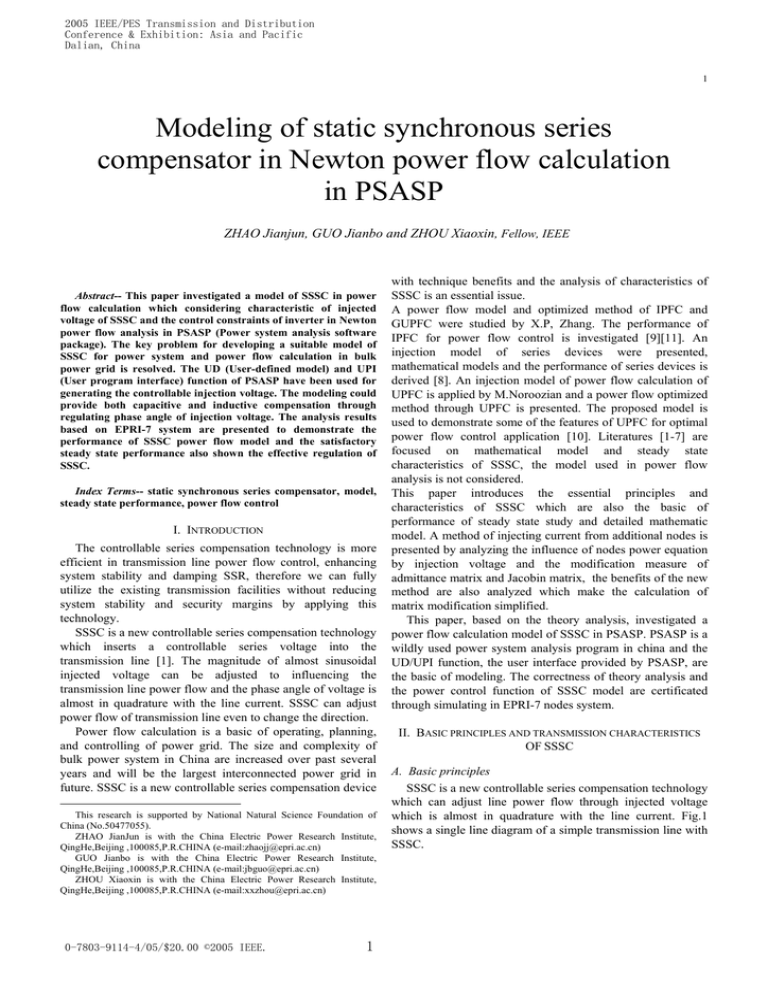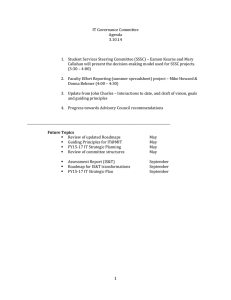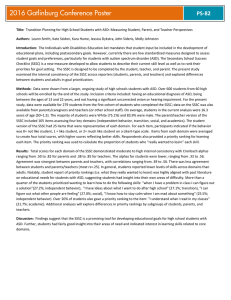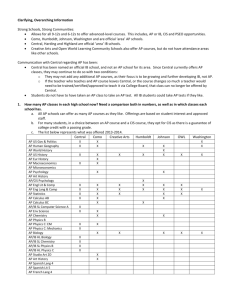Modeling of static synchronous series compensator in Newton
advertisement

2005 IEEE/PES Transmission and Distribution Conference & Exhibition: Asia and Pacific Dalian, China 1 Modeling of static synchronous series compensator in Newton power flow calculation in PSASP ZHAO Jianjun, GUO Jianbo and ZHOU Xiaoxin, Fellow, IEEE Abstract-- This paper investigated a model of SSSC in power flow calculation which considering characteristic of injected voltage of SSSC and the control constraints of inverter in Newton power flow analysis in PSASP (Power system analysis software package). The key problem for developing a suitable model of SSSC for power system and power flow calculation in bulk power grid is resolved. The UD (User-defined model) and UPI (User program interface) function of PSASP have been used for generating the controllable injection voltage. The modeling could provide both capacitive and inductive compensation through regulating phase angle of injection voltage. The analysis results based on EPRI-7 system are presented to demonstrate the performance of SSSC power flow model and the satisfactory steady state performance also shown the effective regulation of SSSC. Index Terms-- static synchronous series compensator, model, steady state performance, power flow control I. INTRODUCTION The controllable series compensation technology is more efficient in transmission line power flow control, enhancing system stability and damping SSR, therefore we can fully utilize the existing transmission facilities without reducing system stability and security margins by applying this technology. SSSC is a new controllable series compensation technology which inserts a controllable series voltage into the transmission line [1]. The magnitude of almost sinusoidal injected voltage can be adjusted to influencing the transmission line power flow and the phase angle of voltage is almost in quadrature with the line current. SSSC can adjust power flow of transmission line even to change the direction. Power flow calculation is a basic of operating, planning, and controlling of power grid. The size and complexity of bulk power system in China are increased over past several years and will be the largest interconnected power grid in future. SSSC is a new controllable series compensation device This research is supported by National Natural Science Foundation of China (No.50477055). ZHAO JianJun is with the China Electric Power Research Institute, QingHe,Beijing ,100085,P.R.CHINA (e-mail:zhaojj@epri.ac.cn) GUO Jianbo is with the China Electric Power Research Institute, QingHe,Beijing ,100085,P.R.CHINA (e-mail:jbguo@epri.ac.cn) ZHOU Xiaoxin is with the China Electric Power Research Institute, QingHe,Beijing ,100085,P.R.CHINA (e-mail:xxzhou@epri.ac.cn) 0-7803-9114-4/05/$20.00 ©2005 IEEE. 1 with technique benefits and the analysis of characteristics of SSSC is an essential issue. A power flow model and optimized method of IPFC and GUPFC were studied by X.P, Zhang. The performance of IPFC for power flow control is investigated [9][11]. An injection model of series devices were presented, mathematical models and the performance of series devices is derived [8]. An injection model of power flow calculation of UPFC is applied by M.Noroozian and a power flow optimized method through UPFC is presented. The proposed model is used to demonstrate some of the features of UPFC for optimal power flow control application [10]. Literatures [1-7] are focused on mathematical model and steady state characteristics of SSSC, the model used in power flow analysis is not considered. This paper introduces the essential principles and characteristics of SSSC which are also the basic of performance of steady state study and detailed mathematic model. A method of injecting current from additional nodes is presented by analyzing the influence of nodes power equation by injection voltage and the modification measure of admittance matrix and Jacobin matrix, the benefits of the new method are also analyzed which make the calculation of matrix modification simplified. This paper, based on the theory analysis, investigated a power flow calculation model of SSSC in PSASP. PSASP is a wildly used power system analysis program in china and the UD/UPI function, the user interface provided by PSASP, are the basic of modeling. The correctness of theory analysis and the power control function of SSSC model are certificated through simulating in EPRI-7 nodes system. II. BASIC PRINCIPLES AND TRANSMISSION CHARACTERISTICS OF SSSC A. Basic principles SSSC is a new controllable series compensation technology which can adjust line power flow through injected voltage which is almost in quadrature with the line current. Fig.1 shows a single line diagram of a simple transmission line with SSSC. 2 X1 I III. POWER FLOW ANALYSIS IN POWER GRID WITH SSSC X2 Vss SSSC is a compensation measure aimed to longitudinal elements of transmission lines, it’s control object is not modify the branches parameters, as TCSC done, but is materialized the control effect of injection voltage. A method of modifying admittance matrix through additional nodes and modifying Jacobin matrix by additional injection quantity is presented which resolve the problem satisfactorily. V2 V1 Converter Controller A. Modifying admittance matrix Fig.1 Single line diagram of SSSC The allocation of SSSC in transmission line is arbitrary which could be achieved by added two nodes in compensated transmission line and the admittance matrix is also modified. It could be supposed that SSSC is installed at send end of ' ' transmission line, show in Fig.4, nodes i and j are added in branch ij, y ss is additional admittance which consider the loss of series transformer and inverter circuit of SSSC. B. Transmission characteristics Line current I has not influence on the amplitude of injected voltage U in . The phase angle of injected voltage, lagging phase angle of line current 90˚ in capacitive compensation mode, makes line current increasing and thereby enhancing power flow without changing power angle. In inductive compensation mode the condition is reversed, it is showed in Fig.2. Therefore, SSSC can control line power flow flexible and improving power system stability obviously. V1 V•sj jIX 2 • V2 • Vsi jIX 2 • Vsj Vsi δ θ • • Vss δ θ • V2 • I I No compensation • • I Capacitive compensation jIX 1 Power system • Vss Yij1 jIX 2 V2 i Inductive compensation Active power and reactive power of transmission line with SSSC are described by (1) and (2) respectively. (1) Vss V1V2 sin δ Q= x1 + x2 (1 − V12 + V22 − 2V1V2 cos δ (2) Fig. 3 shows the transmission characteristics of SSSC, the changing of Vss can improve transmission characteristics, increase power system transfer capability and enhance system stability. 1.4 0.9 0.4 0 10 20 30 40 50 60 70 80 Yij ‘ i ‘ j j Despite two additional nodes, a little amount of calculation of modification admittance matrix is needed. The modified admittance matrix is presented in (3). 0 0 Y11 L Y1i L Y1 j L Y1n M M M M M M 0 Yi1 L Yii' L 0 L Yin Yii ' M M M M M (3) M ' ' 0 Y jj ' Y B = Y j1 L 0 L Y jj L Y jn M M M M M M Yn1 L Yni L Y nj L Ynn 0 0 0 L Y i ' i L 0 L 0 Yi ' i ' Y i ' j ' 0 L 0 L Y ' L 0 Y '' Y j j ji j' j' Where the modify value is: ' Yii' = Yii − yij + yij1 ; Y jj = Y jj − yij + yij 2 ) Vss V1 (V1 −V2 cosδ ) )(1 − ) x1 + x2 V12 + V22 − 2V1V2 cosδ -0.1 Yij 2 Fig.4 The admittance matrix is modified by adding two additional nodes in transmission line Fig.2 Phasor diagram of SSSC P= j Yij • V1 jIX 1 • jIX 1 θ i • • V1 δ Power system Yii ' = Yi ' i = − yij1 ; Y jj = Y j j = − yij 2 ' 90 100 110 120 130 140 150 160 170 180 ' Yi 'i ' = y ij1 + y ss ; Y j j = y ij 2 + y ss ' ' -0.6 L-0.4 without C-0.4 Yi ' j ' = Y j 'i ' = y ss Fig.3 SSSC Transmission characteristics The other elements were not changed due to have no relationship with additional nodes. 2 3 B. Power equation According to Fig.4, the injection voltage Vss∠θ ss , which is ∆Pi ' j ' = Pi ' j ' − Pijref , ∆Qi ' j ' = Qi ' j ' − Qijref Two state variables, θss and V ss , are added, θss is changed derived by SSSC, will affect the power equation of nodes i ' and j ' while the other nodes power equation have not along with current of corresponding transmission line, and θin = θij ± 90° where θ ij is the phase angle of current of changed. The power equation of nodes i ' and j ' are given by corresponding transmission line. The constraints of power flow is Vss min ≤ Vss ≤ Vss max Pi ' = Vi ' Gi 'i ' +Vi ' [Vi (Gi 'i cosδi 'i + Bi 'i sinδi 'i ) 2 +V j ' (Gi ' j ' cosδi ' j ' + Bi ' j ' sinδi ' j ' )] θ ss = θij ± 90° , − π ≤ θ ij ≤ π +Vi 'Vss [Gi ' j ' cos(δi ' −θss ) + Bi ' j ' sin(δi ' −θss )] Pij = Pijref , Qij = Qijref Qi ' = −Vi '2 Bi 'i ' + Vi ' [Vi (Gi 'i sin δ i 'i − Bi 'i cos δ i 'i ) (4) + V j ' (Gi ' j ' sin δ i ' j ' − Bi ' j ' cos δ i ' j ' )] IV. MODELING OF POWER FLOW CONTROLLER OF SSSC IN PSASP + Vi 'Vss (Gi ' j ' sin(δ i ' − θ in ) − Bi ' j ' cos(δ i ' − θ in )) Pi ' j ' = Vi '2Gi 'i ' +Vi 'V j ' (Gi ' j ' cosδi ' j ' + Bi ' j ' sinδi ' j ' )] A. The method of injecting current from additional nodes SSSC is a compensation measure aimed to longitudinal elements of transmission lines, it’s control object is not modify the branches parameters but is materialized the control effect of injection voltage. The theory of voltage source and current source exchanging is adopted so that the injection voltage could be equal to injection current which is injected in additional nodes. It is showed in Fig.5 and Fig.6. +Vi 'Vss [Gi ' j ' cos(δi ' −θss ) + Bi ' j ' sin(δi ' −θss )] Qi ' j ' = −Vi '2 Bi 'i ' + Vi 'V j ' (Gi ' j ' sin δ i ' j ' − Bi ' j ' cos δ i ' j ' )] (5) + Vi 'Vss (Gi ' j ' sin(δ i ' − θ ss ) − Bi ' j ' cos(δ i ' − θ ss )) It could derived from equation (5) P =P + ∆P ; Q = Q + ∆Q i' j ' i' j' ( 0) i' j' i' j' i' j' ( 0) i' j' Where P ' ' is transmission line power flow without SSSC, i j (0) ∆Pi ' j ' is increment of power flow after compensation and is Il also the injection power of SSSC. C. Modifying Jacobin matrix The injection voltage effeteness of Jacobin matrix can be presented as ∂P1 ∂δ 1 ∂Q1 ∂δ 1 M ∂P ∆P1 i ∆Q ∂δ1 1 ∂Q M i ∂δ1 ∆Pi M ∆Qi ∂Pj M ∂δ1 ∆Pj ∂Q = j ∆Qj ∂δ1 M M ∂P ∆Pn n ∆P' ∂δ1 i ∂P' ∆Pj' i ∆P ∂δ1 i' j' ∂P ' ∆Qi' j' j ∂δ 1 0 0 ∂P1 V1 ∂V1 ∂Q1 V1 ∂V1 M ∂Pi V1 ∂V1 ∂Qi V1 ∂V1 M ∂Pj V1 ∂V1 ∂Qj V1 ∂V1 M ∂Pn V1 ∂V1 ∂Pi' V ∂V1 ∂Pj' V1 ∂V1 0 0 ∂P1 ∂P1 Vi ∂δi ∂Vi ∂Q1 ∂Q1 L Vi ∂δi ∂Vi M M M ∂Pi ∂Pi L Vi ∂δi ∂Vi ∂Qi ∂Qi L Vi ∂δi ∂Vi M M M ∂Pj ∂Pj L Vi ∂δi ∂Vi ∂Qj ∂Qj L Vi ∂δi ∂Vi M M M ∂Pn ∂Pn L Vi ∂δi ∂Vi ∂Pi' ∂Pi' M M Vi ∂δi ∂Vi ∂Pj' ∂Pj' L Vi ∂δi ∂Vi ∂Pi' j' ∂Pi' j' L Vi ∂δi ∂Vi ∂Qi' j' ∂Qi' j' L Vi ∂δi ∂Vi L ∂P1 ∂δ j ∂Q1 L ∂δ j M M ∂Pi L ∂δ j ∂Qi L ∂δ j M M ∂Pj L ∂δ j ∂Qj L ∂δ j M M ∂Pn L ∂δ j ∂Pi' M ∂δ j ∂Pj' L ∂δ j ∂Pi' j' 0 ∂δ j ∂Qi' j' 0 ∂δ j L ∂P1 Vj ∂Vj ∂Q1 Vj ∂Vj M ∂Pi Vj ∂Vj ∂Qi Vj ∂Vj M ∂Pj Vj ∂Vj ∂Qj Vj ∂Vj M ∂Pn Vj ∂Vj ∂Pi' Vj ∂Vj ∂Pj' Vj ∂Vj ∂Pi' j' Vj ∂Vj ∂Qi' j' Vj ∂Vj ∂P1 ∂δn ∂Q1 L ∂δn M M ∂P L i ∂δn ∂Qi L ∂δn M M ∂Pj L ∂δn ∂Qj L ∂δn M M ∂P L n ∂δn ∂Pi' M ∂δn ∂Pj' L ∂δn L 0 0 0 0 ∂P1 ∂δi' ∂Q1 ∂δi' M ∂Pi ∂δi' ∂Qi ∂δi' M ∂Pj ∂P1 ∂δ j' ∂Q1 ∂δ j' M ∂Pi ∂δ j' ∂Qi ∂δ j' M ∂Pj M ∂Pi ∂θss ∂Qi ∂θss 0 ∂Pj ∂δi' ∂Qj ∂δ j' ∂Qj ∂θss ∂Qj ∂δi' M ∂Pn ∂δi' ∂Pi' ∂δ j' M ∂Pn ∂δ j' ∂Pi' ∂θss 0 ∂δi' ∂Pj' ∂δi' ∂Pi' j' ∂δi' ∂Qi' j' ∂δ j' ∂δ j' ∂Pj' 0 0 0 ∂Pi' ∂θss ∂Pj' ∂δ j' ∂θss ∂Pi' j' ∂Pi' j' Vi' ∂Vi' ∂θss ∂Qi' j' ∂Qi' j' Vj' ∂Vj' ∂θss j i Vss Xs Fig.5 The injection voltage scheme of SSSC i 0 M ∆δ1 ∆V ∂Pi Vss 1 ∂Vss V1 ∂Qi M Vss ∂Vss ∆δi ∆V 0 i ∂Pj Vi Vss ∂Vss M ∂Qj ∆δ j Vss ∆V ∂Vss j 0 Vj M 0 ∆δn ∆δ ' ∂Pi' Vss i ∂Vss ∆δ j' ∂Pj' ∆θss Vss ∆V ss ∂Vss ∂Pi' j' Vss Vss ∂Vss ∂Qi' j' Vss ∂Vss i' 0 I ss j i' bss I ss Fig.6 The injection current scheme of SSSC by adding two additional nodes The injection voltage of SSSC is presented by injection current of bus i ' and bus j ' which could derived by • Il I ss = ±bss k Il • (7) Where bss is admittance of series transformer and DC circuit of SSSC. • I l is current of transmission line which is compensated by SSSC. k is proportion factor of injection voltage and equivalent injection current. The method of injecting current from additional nodes increase dimension of admittance matrix so that the amount of modify calculation is more than those in directly modify admittance of branches, but the amount of modify calculation of Jacobin matrix is simplified because the influence of (6) Where ∆Pi and ∆Qi are mismatch value of active power and reactive power of bus i, Pi and Qi are active power and reactive power injected into bus i (i=1-n). The control effect could be presented by the last four rows and the last four columns in (6), ∆P ' ' and ∆Q ' ' are active and reactive power i j i j control portion respectively. ' injection current is limited in nodes i , i , j and j ' which could 3 4 be derived from (4). If injection voltage is directly added in branch ij that Power equation of all branches corresponding to node i and node j will have an append term Vss , the amount of 14 12 10 8 calculation is increased. 6 B. The power flow program of SSSC in PSASP PSASP is broadly used as power system analysis soft ware package in China which including models of SVC, TCSC, HVDC in power flow program and transient analysis program[12][13]. The control function are achieved by special subprogram which exchange datum with main power flow program through interface program so that it could develop new function by commerce software package without developing full power flow software. PSASP provide convenient user interface function which could make user achieved additional calculate and control function through UPI and UD. The model of SSSC of power flow analysis is achieved through control element and I/O interface variables provided by UD. The UD model has the characteristic of independent and ease to using, so the SSSC model could be used conveniently in any power system. Fig.7 is the frame of power flow control module. 4 2 0 0 2 4 6 8 10 Pl1 12 14 16 18 Pl2 20 22 24 26 Pl3 28 30t(s) 28 30 Pl5 Fig.9 The power flow control by SSSC 0 2 4 6 8 10 12 14 16 18 20 22 24 26 0.2 0.15 0.1 0.05 0 -0.05 -0.1 t(s) Fig.10 The injection voltage of SSSC 0 2 4 6 8 10 12 14 16 18 20 22 24 26 28 30 12 10 8 6 4 Input datum of UD mod el 2 Main program Controller of UD model of PSASP power flow 0 t(s) -2 Qij softwarer Output datum of UD mod el Pij Il1 Fig.11 The injection active and reactive power of SSSC Fig.7 The power flow control frame of SSSC The active power control is speedily and exactly by SSSC. SSSC could redistribute active power as needed between two shunt lines. The value of Vss is 0.20 which increase the active EPRI-7 system has two machines and an infinite bus which connected through double circuit and a HVDC line, showed in Fig.8. SSSC is installed at L1 near bus B1-500 which controls the power flow of L1. G1 B1 - 500 1 : 1.05 L2 0.0038+ j0.0406/1.088 Bj Bi 0.0 + j0.01 B4 - 500 L4 B3 - 500 0.0038+ j0.0406/1.088 1 : 1.05 0.0038+ j0.0406/1.088 0.0038+ j0.0406/1.088 L3 S1 0.0 + j0.0067 0.0 + j0.02 1 : 1.0 j0.6666 L1 power of L1 from 680MW to 1000MW and transfer capability increased about 47% while the injection power of SSSC is 195Mvar. The phasor diagram of corresponding node voltages is showed at Fig.12 (a). Not only the transfer capability is increased but also the difference of angle between sending end and receiving end is decreased from 19 .97 ° to 11 .47 ° . Due to influence of injection voltage, the voltage between node i and node j is reversed which has showed in Fig.12(b) and the simulation result also testify the correctness of model. B2 - 500 G2 1 : 1.05 Converter Controller SSSC L5 0.8 0.0 + j0.0067 VB1 0.7 VBj VBj 0.6 Fig.8 The EPRI-7 power system with SSSC VB1 0.5 VB4 0.4 C. Case analysis 0.3 Case1:Capacitive compensation The control target of active power of L1 is 1000MW and the simulation result is showed in Fig.9 to Fig. 11. VB4 0.2 0.1 0 0 0.2 Initial condition 0.4 0.6 0.8 1 With SSSC (a) 4 5 -0.2 -0.15 -0.1 -0.05 0 0.05 0.1 are compared. SSSC could achieve the same control purpose with lower output power and the benefits of SSSC are more evident than TCSC especial in lower transmission power condition. The main works of this paper as follows. The characteristics and mathematic model are analyzed. A method of injecting current from additional nodes is presented which materialized the modification of admittance matrix and Jacobin matrix. The model of SSSC used in power flow analysis is presented and the correctness is validated. The characteristics of SSSC are compared with those of TCSC and the benefits of SSSC are illuminated by simulation results. 0.15 0.5 0.4 3 1 0.3 3 1 0.2 0.1 2 0 -0.1 2 -0.2 Initial condition • With SSSC • • VI. REFERENCES (b) • • [1] • 1= V B1 − V B 4 、2= V Bi − V Bj 、3= V Bj − V B 4 Fig.12 The influence of nodes voltage by SSSC [2] Case2:Inductive compensation The simulation result of inductive compensation is same as capacitive compensation which is showed in Fig.13 and Fig.14. [3] 0 2 4 6 8 10 12 14 16 18 20 22 24 26 28 [4] 30 8 7 6 5 4 3 2 1 0 -1 -2 [5] [6] t(s) Qij [7] Pi Fig.13 The power flow control by SSSC 0 2 4 6 8 10 12 14 16 18 20 22 24 26 28 30 [8] 0.2 0.15 [9] 0.1 0.05 0 [10] t(s) -0.05 Fig.14 The injection voltage of SSSC [11] V. CONCLUSIONS [12] This paper investigated a practical model of SSSC in power flow analysis. The method of injecting current from additional nodes is presented by a modification measure of admittance matrix and Jacobin matrix, and the benefits of the new method are analyzed. A model of SSSC in power flow analysis is realized through the user interface programmer of PSASP and the problem of power flow analysis in bulk power system with SSSC is resolved. The correctness of theory analysis and power control function of SSSC model are certificated through simulation in EPRI-7 nodes system and control characteristics of TCSC and SSSC in same control condition [13] 5 Kalyan K. Sen, SSSC-Static Synchronous Series Compensator : Theory, Modeling, and Applications[J], IEEE Trans. on Power Delivery, Vol. 13, No.1, January 1998,241-246 Laszlo Gyugyi, Colin D. Schauder, Kalyan K. Sen, Static Synchronous Series Compensator: A Solid-State Approach to The Series Compensation of Transmission Lines [J] , IEEE Trans. on Power Delivery,Vol.12,No.1,January 1997,406-417 R. Mihalič,I. Papič, Mathematical Models and Simulation of a Static Synchronous Series Compensator[C] , University of Ljubljana Ljubljana, Slovenia Kalyan K.Sen, Eric J Stacey, UPFC-Unified power flow controller Theory, Modeling and Applications[J],IEEE Trans. on Power Delivery, Vol. 13, No. 4, October 1998.1453-1460 Edvina Uzunovic, Claudio A. Canizares, John Reeve, Fundamental Frequency Model of Unified Power Flow Controller[C] , North American Power Symposium (NAPS), San Luis Obispo, California, October 1999 L. Sunil Kumar, Arindam Ghosh, Modeling and control design of a static synchronous series compensator, IEEE Trans. on Power Delivery,Vol.14, No.4 , pp.1448-1453, 1999 A. Nabavi-Niaki and M.R. Iravani, Steady-State and Dynamic Models of Unified Power Flow Controller (UPFC) for Power System Studies [J], IEEE Trans. on Power Systems, Vol. 11, No.4, November 1996, pp.1937-1943. Mehrdad Ghandhari,Göran Andersson,Ian A. Hiskens, Control Lyapunov Functions for Controllable Series Devices,IEEE Trans. on Power Systems, VOL. 16, NO. 4, Nov.2001 X.P.Zhang, Modeling of the interline power flow controller and the generalized unified power flow controller in Newton power flow,IEE Proc.-Gener. Transm. Distrib., Vol. 150,No.3,May 2003 M.Noroozian,L.Angquist,M.Ghandhari,G.Andersson,Use of UPFC for optimal power flow control,IEEE Trans. on Power Delivery,Vol.12, No.4, 1997, pp.1629-1634 Xiao-Ping Zhang,Edmund Handschin, Modeling of the Generalized Unified Power Flow Controller (GUPFC) in a Nonlinear Interior Point OPF,IEEE Trans. on Power System,VOL. 16, NO. 3, AUG 2001. Power system analysis software package, load flow calculation user’s manual,Electric Power Research Institute of China. Power system analysis software package, User-defined model& User program interface, Electric Power Research Institute of China.





